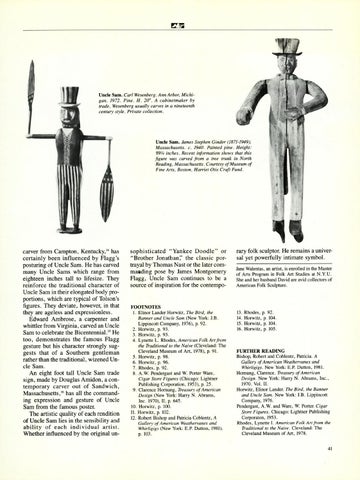Uncle Sam. Carl Wesenberg. Ann Arbor, Michigan. 1972. Pine. H. 20". A cabinetmaker by trade, Wesenberg usually carves in a nineteenth century style. Private collection.
Uncle Sam. James Stephen Ginder (1871-1949). Massachusetts. c. 1940. Painted pine. Height: 89/ 1 4 inches. Recent information shows that this figure was carved from a tree trunk in North Reading, Massachusetts. Courtesy ofMuseum of Fine Arts, Boston, Harriet Otis Cruft Fund.
carver from Campton, Kentucky,'째 has certainly been influenced by Flagg's posturing of Uncle Sam. He has carved many Uncle Sams which range from eighteen inches tall to lifesize. They reinforce the traditional character of Uncle Sam in their elongated body proportions, which are typical of Tolson's figures. They deviate, however, in that they are ageless and expressionless. Edward Ambrose, a carpenter and whittler from Virginia, carved an Uncle Sam to celebrate the Bicentennial.' He too, demonstrates the famous Flagg gesture but his character strongly suggests that of a Southern gentleman rather than the traditional, wizened Uncle Sam. An eight foot tall Uncle Sam trade sign, made by Douglas Amidon, a contemporary carver out of Sandwich, Massachusetts,16 has all the commanding expression and gesture of Uncle Sam from the famous poster. The artistic quality of each rendition of Uncle Sam lies in the sensibility and ability of each individual artist. Whether influenced by the original un-
sophisticated "Yankee Doodle" or "Brother Jonathan': the classic portrayal by Thomas Nast or the later commanding pose by James Montgomery Flagg, Uncle Sam continues to be a source of inspiration for the contempo-
FOOTNOTES 1. Elinor Lander Horwitz, The Bird, the Banner and Uncle Sam (New York: J.B. Lippincott Company, 1976), P. 92. 2. Horwitz, p. 93. 3. Horwitz, p. 93. 4. Lynette L. Rhodes, American Folk Artfrom the Traditional to the Naive (Cleveland: The Cleveland Museum of Art, 1978), p. 91. 5. Horwitz, p. 98. 6. Horwitz, p. 96. 7. Rhodes, p. 92. 8. A.W. Pendergast and W. Porter Ware, Cigar Store Figures (Chicago: Lightner Publishing Corporation, 1953), p. 25. 9. Clarence Hormmg, Treasury ofAmerican Design (New York: Harry N. Abrams, Inc. 1970), II, p. 645. 10. Horwitz, P. 100. 11. Horwitz, p. 102. 12. Robert Bishop and Patricia Coblentz, A Gallery of American Weathervanes and Whirligigs(New York: E.P. Dutton, 1981), p. 103.
rary folk sculptor. He remains a universal yet powerfully intimate symbol. Jane Walentas, an artist, is enrolled in the Master of Arts Program in Folk Art Studies at N.Y.U. She and her husband David are avid collectors of American Folk Sculpture.
13. Rhodes, p. 92. 14. Horwitz, p. 104. 15. Horwitz, p. 104. 16. Horwitz, p. 105.
FURTHER READING Bishop, Robert and Coblentz, Patricia. A Gallery ofAmerican Weathervanes and Whirligigs. New York: E.P. Dutton, 1981. Hornung, Clarence. Treasury ofAmerican Design. New York: Harry N. Abrams, Inc., 1970. Vol. II. Horwitz, Elinor Lander. The Bird, the Banner and Uncle Sam. New York: J.B. Lippincott Company, 1976. Pendergast, A.W. and Ware, W. Porter. Cigar Store Figures. Chicago: Lightner Publishing Corporaton, 1953. Rhodes, Lynette I. American Folk Artfrom the Traditional to the Naive. Cleveland: The Cleveland Museum of Art, 1978. 41
